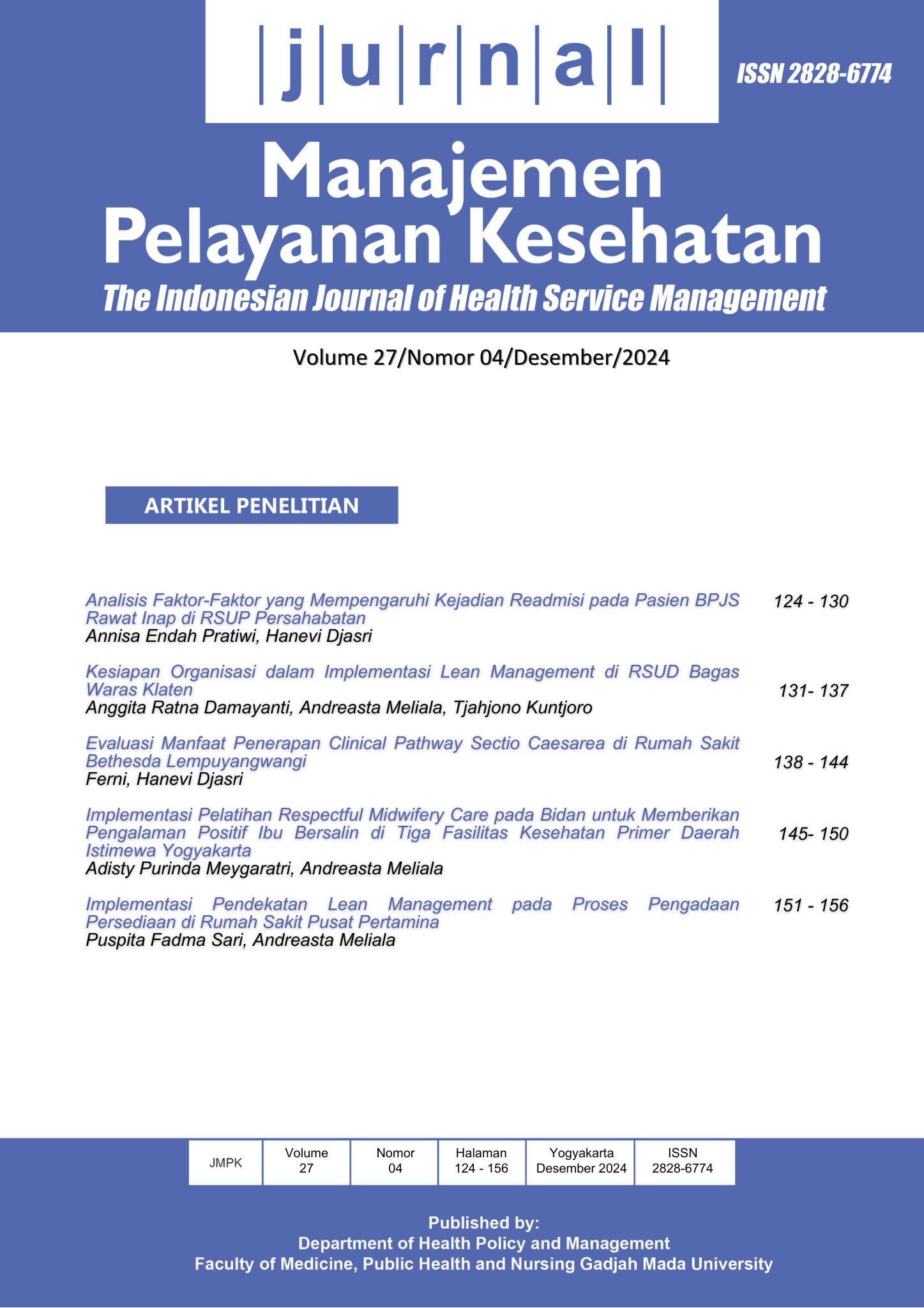EVALUASI MANFAAT PENERAPAN CLINICAL PATHWAY SECTIO CAESAREA DI RUMAH SAKIT BETHESDA LEMPUYANGWANGI
Evaluation of the Benefits of Implementing Cesarean Section Clinical Pathway at Bethesda Lempuyangwangi Hospital
Abstract
Background: Cesarean section (SC) is one of the most performed surgical procedures in the world, as well as in Bethesda Lempuyangwangi Hospital (RSBL). This action is included in the high volume and high-cost category, so a guide is needed to reduce variations in patient care. Clinical pathway (CP) is a tool to improve the process of preparation, management, and clinical outcomes of patients. RSBL has developed a CP for SC since 2019, but there has never been an evaluation of the benefits of its implementation.
Objectives: To evaluate the benefits of SC CP implementation on laboratory test compliance, prophylactic antibiotic prescribing compliance, incidence of surgical wound infection, length of stay, and APGAR score.
Methods: This was an observational analytic study with an ex-post facto research design. The subjects of this study were all patients undergoing elective SC surgery at RSBL who met the inclusion criteria in the period before and after the implementation of SC CP. The variables evaluated were compliance with laboratory tests, compliance with prophylactic antibiotic prescribing, incidence of surgical wound infection, length of stay, and APGAR score.
Results: Compliance of laboratory tests increased from 6.7% to 100%, compliance of prophylactic antibiotic prescribing increased from 3.4% to 84.3%, the incidence of surgical wound infection decreased from 1.10% to 0.0%, and variation in the length of stay decreased from 2-4 days to 3 days (100%). The mean first-minute APGAR score did not change (7), while the 5th and 10th-minute scores decreased from 9 to 8, and 10 to 9, respectively.
Conclusions: The implementation of CP SC was beneficial in improving laboratory testing compliance and prophylactic antibiotic prescribing compliance, reducing the incidence of surgical wound infection, and reducing variation in the length of stay, but could not improve the APGAR score.
Keywords: Clinical pathway, sectio caesarea, laboratory testing, prophylactic antibiotic, length of stay
References
2. Jason Cheah. Clinical pathways--an evaluation of its impact on the quality of care in an acute care general hospital in Singapore. Singapore Med J. 2000;41(7):335–46.
3. El Baz N, Middel B, Van Dijk JP, Oosterhof A, Boonstra PW, Reijneveld SA. Are the outcomes of clinical pathways evidence-based? A critical appraisal of clinical pathway evaluation research. J Eval Clin Pract. 2007;13(6):920–9.
4. Riza RC, Nurwahyuni A. The Implementation and Outcome of Clinical Pathway: A Systematic Review. 2019;677–86.
5. Deneckere S, Euwema M, Lodewijckx C, Panella M, Mutsvari T, Sermeus W, et al. Better interprofessional teamwork, higher level of organized care, and lower risk of burnout in acute health care teams using care pathways: A cluster randomized controlled trial. Med Care. 2013;51(1):99–107.
6. Badan Pusat Statistik. Profil Kesehatan Ibu dan Anak 2022. 2022.
7. Cavazos-Rehg PA, Krauss MJ, Spitznagel EL, Bommarito K, Madden T, Olsen MA, et al. Maternal Age and Risk of Labor and Delivery Complications. Matern Child Health J. 2015;19(6):1202–11.
8. Badan Pusat Statistik. Sensus Penduduk 2020. BpsGoId [Internet]. 2023;(27):1–52. Available from: https://papua.bps.go.id/pressrelease/2018/05/07/336/indeks-pembangunan-manusia-provinsi-papua-tahun-2017.html
9. Sulastri S, Maliya A, Mufidah N, Nurhayati E. Kontribusi Jumlah Kehamilan (Gravida) Terhadap Komplikasi Selama Kehamilan dan Persalinan. J Ilmu Keperawatan Matern. 2019;2(1):9.
10. Reddy UM, Bettegowda VR, Dias T, Yamada-Kushnir T, Ko CW, Willinger M. Term Pregnancy. Obstet Gynecol. 2011;117(6):1279–87.
11. Chauhan MB, Malik R. Postterm Pregnancy. Labour Room Emergencies. 2019;4(3):173–81.
12. Putri MS, Titisari I, Setyarini AI. Hubungan Usia Kehamilan Dengan Komplikasi Pada Bayi Baru Lahir Di Rs Aura Syifa Kabupaten Kediri Tahun 2017. J Ilmu Kesehat. 2017;6(1):101.
13. Wulan D, Rengganis S, Rahmayani F, Kedokteran F, Lampung U, Masyarakat BK, et al. Faktor Risiko Bayi Berat Lahir Rendah Risk Factors For Low Birth Weight Babies. Medula. 2023;13(1):136–40.
14. Anil KC, Basel PL, Singh S. Low birth weight and its associated risk factors: Health facility-based case-control study. PLoS One [Internet]. 2020;15(6 June):1–10. Available from: http://dx.doi.org/10.1371/journal.pone.0234907
15. Rudianto, Sudjadi A, Widodo HB. Doctor’s Compliance to Clinical Pathway of Ischaemic Stroke: A Case of Private Hospital in Indonesia. 2019;5.
16. Panella M, Marchisio S, Di Stanislao F. Reducing clinical variations with clinical pathways: Do pathways work? Int J Qual Heal Care. 2003;15(6):509–21.
17. Vianti,.A. & P. Gambaran Biaya Sectio Caesarean dengan Clinical Pathway pada Pasien JKN RS Hermina Jatinegara Tahun 2011. J Ilm Indones [Internet]. 2022;7(9):1–10. Available from: https://jurnal.syntaxliterate.co.id/index.php/syntax-literate/article/view/9197
18. Park S, Kim S, Kim H Bin, Youn SW, Ahn S, Kim K. Effects of implementing a clinical pathway on antibiotic prophylaxis for patients who underwent an elective surgery. Sci Rep [Internet]. 2022;12(1):1–8. Available from: https://doi.org/10.1038/s41598-022-24145-1
19. Herawati F, Irawati AD, Viani E, Sugianto NA, Rahmatin NL, Artika MP, et al. Effective Clinical Pathway Improves Interprofessional Collaboration and Reduces Antibiotics Prophylaxis Use in Orthopedic Surgery in Hospitals in Indonesia. Antibiotics. 2022;11(3).
20. Kementerian Kesehatan Republik Indonesia. Permenkes No.28 Tahun 2021. Indonesia; 2021.
21. Zunnita O. Pengaruh Antibiotika Profilaksis Terhadap Kejadian Infeksi Luka Operasi. Fitofarmaka J Ilm Farm [Internet]. 2018;8(1):43–9. Available from: http://www.nber.org/papers/w16019
22. Octavianty C, Yulia R, Herawati F, Wijono H. Profil Penggunaan Antibiotik Profilaksis pada Pasien Bedah di Salah Satu RS Swata Kota Surabaya. Media Kesehat Masy Indones. 2021;20(3):168–72.
23. Khan Z, Ahmed N, Rehman A ur, Khan FU, Saqlain M, Martins MAP, et al. Audit of pre-operative antibiotic prophylaxis usage in elective surgical procedures in two teaching hospitals, Islamabad, Pakistan: An observational cross-sectional study. PLoS One [Internet]. 2020;15(4):1–12. Available from: http://dx.doi.org/10.1371/journal.pone.0231188
24. Kawakita T, Huang CC, Landy HJ. Choice of prophylactic antibiotics and surgical site infections after cesarean delivery. Obstet Gynecol. 2018;132(4):948–55.
25. Sumarni T, Yulastri. Clinical Pathway dalam Pelayanan Sectio Caesar. NERS J Keperawatan. 2019;15(1):54–9.
26. Haninditya B, Andayani TM, Yasin NM, Ilmu M, Universitas F, Mada G, et al. Analisis Kepatuhan Pelaksanaan Clinical Pathway Sesarea di Sebuah Rumah Sakit Swasta di Yogyakarta Seksio. J Manaj DAN PELAYANAN Farm (Journal Manag Pharm Pract. 2019;9(1):38–45.
27. Kawakita T, Landy HJ. Surgical site infections after cesarean delivery: epidemiology, prevention and treatment. Matern Heal Neonatol Perinatol. 2017;3(1):1–9.
28. Trimarchi L, Caruso R, Magon G, Odone A, Arrigoni C. Clinical pathways and patient-related outcomes in hospital-based settings: A systematic review and meta-analysis of randomized controlled trials. Acta Biomed. 2021;92(1):1–13.
29. Tanjung HP, Nurwahyuni A. The Impact of Clinical Pathway Implementation on Length of Stay and Hospital Cost: A Systematic Review. 2019;303–303.
30. Federspiel JJ, Suresh SC, Darwin KC, Szymanski LM. Hospitalization Duration following Uncomplicated Cesarean Delivery: Predictors, Facility Variation, and Outcomes. AJP Rep. 2020;10(2):E187–97.
31. Hassan B, Mandar O, Alhabardi N, Adam I. Length of Hospital Stay After Cesarean Delivery and Its Determinants Among Women in Eastern Sudan. Int J Womens Health. 2022;14(May):731–8.
32. Pereira SL, da Silva TPR, Moreira AD, Novaes TG, Pessoa MC, Matozinhos IP, et al. Factors associated with the length of hospital stay of women undergoing cesarean section. Rev Saude Publica. 2019;53:1–8.
33. Cegolon L, Mastrangelo G, Maso G, Pozzo GD, Heymann WC, Ronfani L, et al. Determinants of length of stay after cesarean sections in the Friuli Venezia Giulia Region (North-Eastern Italy), 2005–2015. Sci Rep [Internet]. 2020;10(1):1–26. Available from: https://doi.org/10.1038/s41598-020-74161-2
34. abd El-Razek A. Effect of Implementing Clinical Pathway to Improve Child-Birth and Neonatal Outcomes. Am J Nurs Res. 2018;6(6):454–65.
35. Paudyal L. Comparison of APGAR Score of Newborns with Mode of Delivery and Its Associated Factors. Int J Soc Sci Manag. 2020;7(3):176–82.
Copyright (c) 2024 Ferni

This work is licensed under a Creative Commons Attribution-NonCommercial-ShareAlike 4.0 International License.




